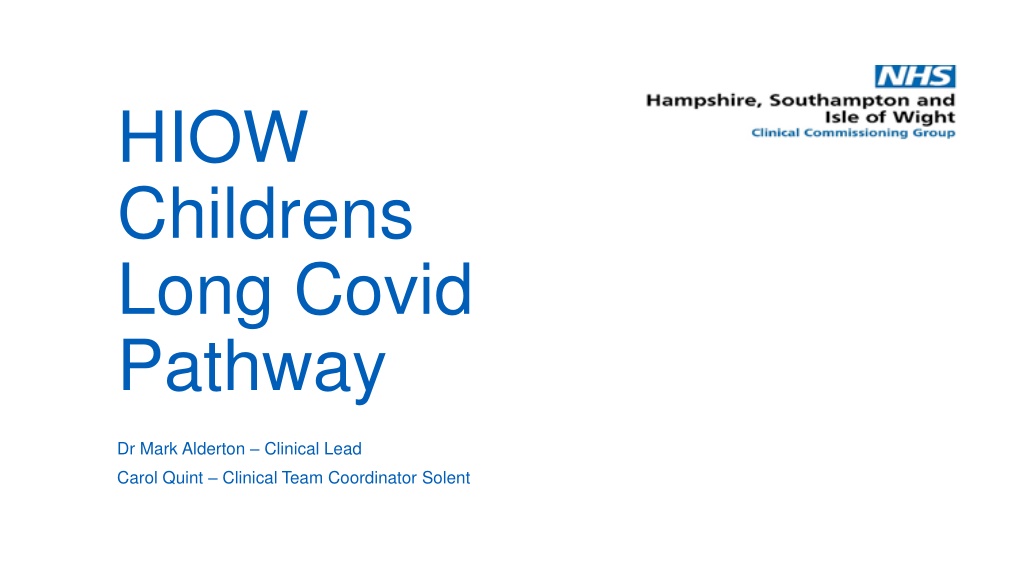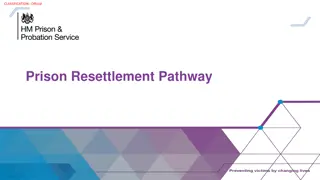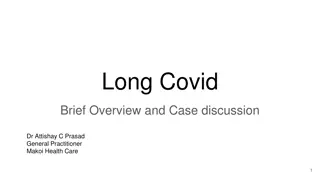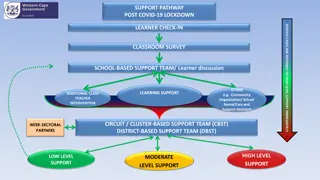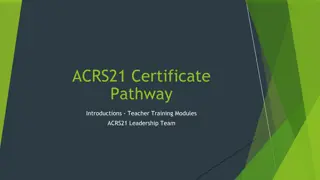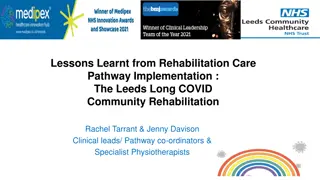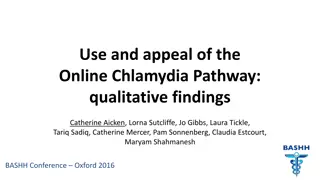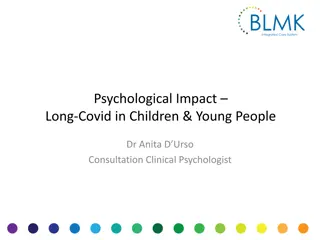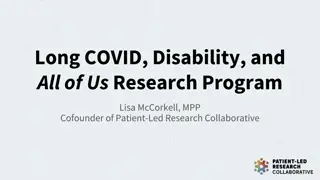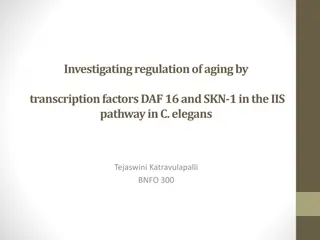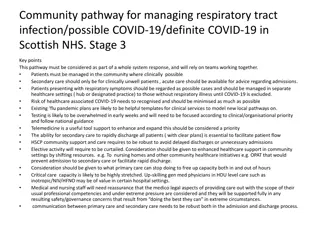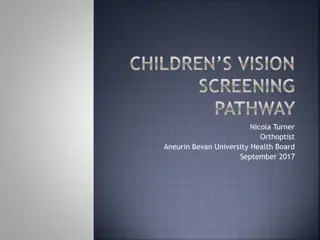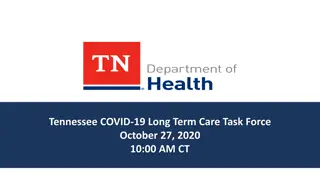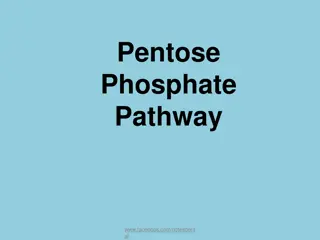Understanding Long COVID in Children - HIOW Pathway Overview
Explore the comprehensive pathway for children with Long COVID in the HIOW region, including definitions, symptoms, and management strategies. Learn about the signs and symptoms of Acute COVID-19, ongoing symptomatic COVID-19, and Post-COVID-19 syndrome. Discover the challenges faced by non-hospitalized children with persistent symptoms and the referral process to the Children's Long COVID syndrome service for continued support and therapy services.
Download Presentation

Please find below an Image/Link to download the presentation.
The content on the website is provided AS IS for your information and personal use only. It may not be sold, licensed, or shared on other websites without obtaining consent from the author. Download presentation by click this link. If you encounter any issues during the download, it is possible that the publisher has removed the file from their server.
E N D
Presentation Transcript
HIOW Childrens Long Covid Pathway Dr Mark Alderton Clinical Lead Carol Quint Clinical Team Coordinator Solent
Definitions and incidence Acute Covid-19 Signs and symptoms of Covid-19 Up to 4 weeks Ongoing symptomatic Covid-19 Signs and symptoms of Covid-19 Up to 4 weeks Post Covid-19 syndrome Signs and symptoms that developed during or after infection Ongoing more than 12 weeks Clusters of symptoms, can fluctuate and change , can affect any system in the body Post Covid-19 can be considered prior to 12/52 while alternate underlying disease investigated.
What does Covid-19 look like for children? NHS & NHS I Long Covid and Children webinar 2021
Fever, rash, abdominal pain, diarrhoea, vomiting, headache, conjunctivitis Paediatric Inflammatory Multisystem Syndrome Low lymphocytes, high neutrophils, v high CRP, low albumin, high fibrinogen, high trophin, high NT-BNP 30-40% severe, shock myocardial dysfunction ECG, abnormalities coronary artery dilation bowel inflammation
Persistent symptoms in non-hospitalised children Energy levels 83.3% Mood 58.8% Sleep 56.3% Appetite 49.6% Multi-system condition Headaches Fatigue Joint pain Sore throat Gastrointestinal issues Nausea Rashes Dizziness Mood changes Chest pain Brain fog
1. Acute COVID-19 - Signs and symptoms of COVID-19 for up to 4 weeks. Managed in primary and/or secondary care. 2. Ongoing symptomatic COVID-19 - Signs and symptoms of COVID-19 4 -12 weeks. Managed in primary and/or secondary care. COVID-19 our local response 3. Post-COVID-19 syndrome / Long COVID - Signs and symptoms that develop during or after an infection consistent with COVID-19, continue for more than 10 weeks and are not explained by an alternative diagnosis. Referral to Childrens Long Covid syndrome service MDT triage Face / face if required Joint working with primary / secondary and specialist services Provide therapy services as indicated review at 12/52 Signpost and support self help / community resources.
Must have GP F2F assessment to consider the following investigations To complete Baseline O2 sats, BP and HR Prior to referral Other tests/ excluded diagnoses Baseline bloods Action abnormal findings via usual secondary care routes - cardiology, respiratory etc Self management resources to be given early
Referral form - sections specific to long Covid pathway Clinical Overview History of suspected Covid-19 infection with one of the three criteria below: 1. Previous PCR positive for SARS-CoV-2 Y/N Date? COVID antibody positivity Date Clear close epidemiological link to be determined on a case by case basis (school/family etc) Date Date of previous positive COVID-19 swab (if performed) Does the individual have one or more of the following as a predominant symptom? Please detail. (i) Severe fatigue that is preventing ADLs e.g. going to school/activities/nursery/ play dates/ regression (ii) Change from baseline that is unacceptable to referring Dr/Pt (iii) Temporally associated persistent unexplained physical symptoms 1. Y/N 1. Y/N
History (including potential fluctuating symptoms and trends) Please rate on scale 0-10 ( 0= no symptoms 10 = severe) Symptom Score 0-10 Fatigue Abdominal pain Anxiety / low mood Sleep Pain Respiratory Brain fog Headache How many days of school /education has the individual missed in the last 2 weeks? (Write N/A if holidays) Does the individual have a history of PIMS-TS? Y/N If Yes refer to secondary care team
Bedside Tests (required) Test Result Heart rate (resting level) Oxygen saturations (resting level) Temperature Blood pressure Result of sit/stand assessment Blood sugar. Blood Tests (required) Test Result Full blood count Blood Film CRP Blood Glucose Urea and electrolytes LFT TFT ESR Coeliac Screen CK Ferritin Vitamin D Vitamin B12 Other Other Tests (performed within the last 4 weeks) Test Result If GI symptoms a faecal calprotectin must be sent Y/N MRI Brain/CXR
Physical, functional, cognitive and psychological assessments, with the aim of improving health outcomes and quality of life. Clincal Lead secondary Care paediatrician (UHS) OT, Physio and Psychology input at assessment and interventions advice, support and structured goal setting, with AHP support. Signposting to national resources Liaison education - universal information and child specific HIOW Childrens Long Covid
Advice, reassurance and referral back to primary care Outcome from MDT assessment Interventions with MDT review at 12 weeks Self management and support from local teams
Management strategies Pacing
Management strategies Sleep and rest
Management strategies Activities and sport
Management options Friends
Management strategies Education
Management strategies Diet
Management strategies Emotional wellbeing
What can Health Care Professionals do? Listen Believe Manage expectations Diagnostics- symptom driven Basic self management advice Signposting / onwards referral Caution with exercise cardiac, respiratory, fatigue Overdoing seems to lead to flare ups Refer to Childrens Long Covid Pathway if indicated.
o FutureNHS Collaboration platform. Long Covid and children webinar 23.4.21. https://future.nhs.uk/L_C_N/view?objectId=99036901 o https://www.physio-pedia.com/30_Seconds_Sit_To_Stand_Test o BMJ Management of post-acute covid-19 in primary care Published: 11/08/2020 o BMJ Webinar Long Covid: How to define it and how to manage it Published: 07/09/2020 o PHE Guidance COVID-19: long-term health effects Published: 07/09/2020 o RCGP Management of the long term effects of COVID-19 V1 o NIHR: Living with Covid Second Review 16/3/21 o https://www.ons.gov.uk/peoplepopulationandcommunity/healthandsocialcare/c onditionsanddiseases/bulletins/prevalenceofongoingsymptomsfollowingcorona viruscovid19infectionintheuk/1april2021 o Royal Society Long Covid: an unfolding story 8 April 2021 accessed at https://royalsociety.org/science-events-and-lectures/2021/04/long-covid/ Useful resources
Contact details Childrens Long Covid Pathway Solent Childrens Therapy SPA 0300 300 2019 SNHS.Solentchildrenstherapyservice@nhs.net
